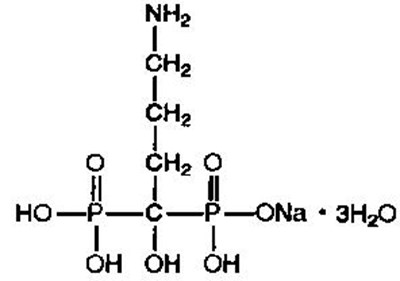Product Images Fosamax
View Photos of Packaging, Labels & Appearance
- image of alendronate sodium chemical structure - fosamax 01
- image of Figure 1 - fosamax 02
- image of Figure 2 - fosamax 03
- image of Figure 3 - fosamax 04
- image of Figure 4 - fosamax 05
- image of Figure 5 - fosamax 06
- image of Figure 6 - fosamax 07
- PRINCIPAL DISPLAY PANEL - 4 Tablet Blister Pack - fosamax 08
Product Label Images
The following 8 images provide visual information about the product associated with Fosamax NDC 78206-135 by Organon Llc, such as packaging, labeling, and the appearance of the drug itself. This resource could be helpful for medical professionals, pharmacists, and patients seeking to verify medication information and ensure they have the correct product.
image of Figure 1 - fosamax 02
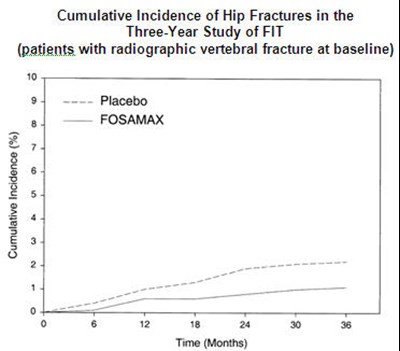
The text provides a graph displaying the cumulative incidence of hip fractures in a three-year study of patients with radiographic vertebral fracture at baseline. The graph compares the incidence rate between two treatments: placebo and FOSAMAX. It shows the incidence rate increases over time for both treatments, but FOSAMAX appears to have a lower incidence rate of hip fractures compared to the placebo.*
image of Figure 2 - fosamax 03
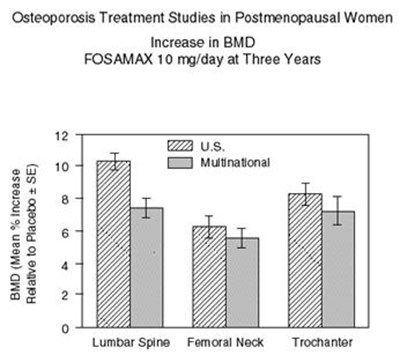
This is a report on the osteoporosis treatment studies conducted on postmenopausal women. The report indicates an increase in bone mineral density (BMD) after three years of treatment with FOSAMAX 10 mg/day. The report also includes measurements for the lumbar spine, femoral neck, and trochanter.*
image of Figure 3 - fosamax 04
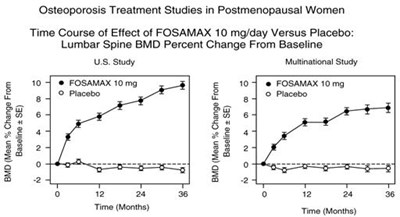
This appears to be a chart or graph showing the percent change in bone mineral density (BMD) of postmenopausal women with osteoporosis treated with FOSAMAX 10 mg/day versus a placebo. The study was conducted over the course of several months, but the exact duration is not clear. The chart compares the mean % change from baseline for FOSAMAX 10 mg/day and placebo, with error bars indicating the standard error.*
image of Figure 4 - fosamax 05
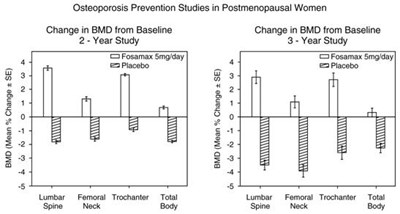
This appears to be a table showing the mean percentage change with standard error in bone mineral density (BMD) measured in different regions of the skeleton, in postmenopausal women in two osteoporosis prevention studies. The studies compared the change in BMD over two and three years in the treatment group (which received Fosamax, a drug used to treat osteoporosis) to the change in the placebo group (which did not receive the drug). The regions of the skeleton measured were the lumbar spine, femoral trochanter, total hip, and body.*
image of Figure 5 - fosamax 06
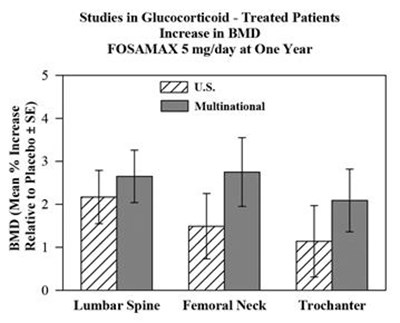
This is a table with some information about a study on the increase in bone mineral density (BMD) in patients treated with glucocorticoids. The table shows the mean percentage increase in BMD relative to a placebo, with standard error (SE) for each category. The categories listed are the Lumbar Spine, Femoral Neck, and Trochanter. The treatment used was FOSAMAX at a dose of 5mg per day for one year. The rest of the text is not readable.*
image of Figure 6 - fosamax 07
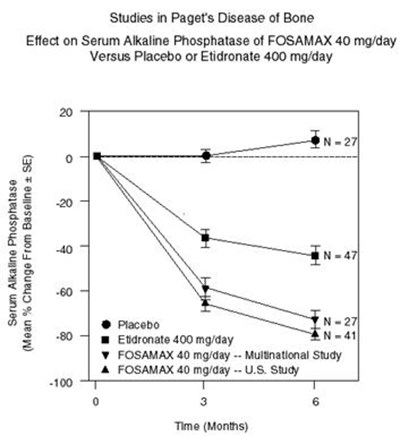
This is a study that compares the effect of FOSAMAX 40 mg/day versus placebo or etidronate 400 mg/day on serum alkaline phosphatase in patients with Paget's disease of bone. The study was conducted in two groups, a multinational study and a US study, involving a total of 27 patients in the placebo group, 8 patients in the etidronate group, and an unspecified number of patients in the FOSAMAX group. The study monitored the patients over a period of 6 months.*
PRINCIPAL DISPLAY PANEL - 4 Tablet Blister Pack - fosamax 08
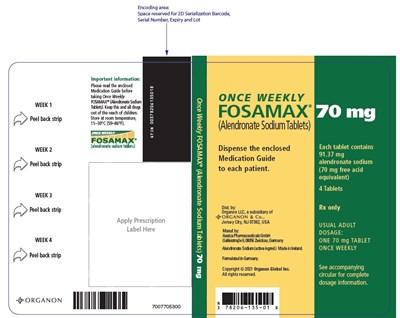
This appears to be a medication label for Fosamax, a drug used to treat or prevent osteoporosis. It provides instructions for the dosage and administration of the medication. The label includes information such as the product name, dosage strength, and manufacturer details. It also has a space reserved for a 2D serialization barcode, serial number, expiry, and lot number.*
* The product label images have been analyzed using a combination of traditional computing and machine learning techniques. It should be noted that the descriptions provided may not be entirely accurate as they are experimental in nature. Use the information in this page at your own discretion and risk.
